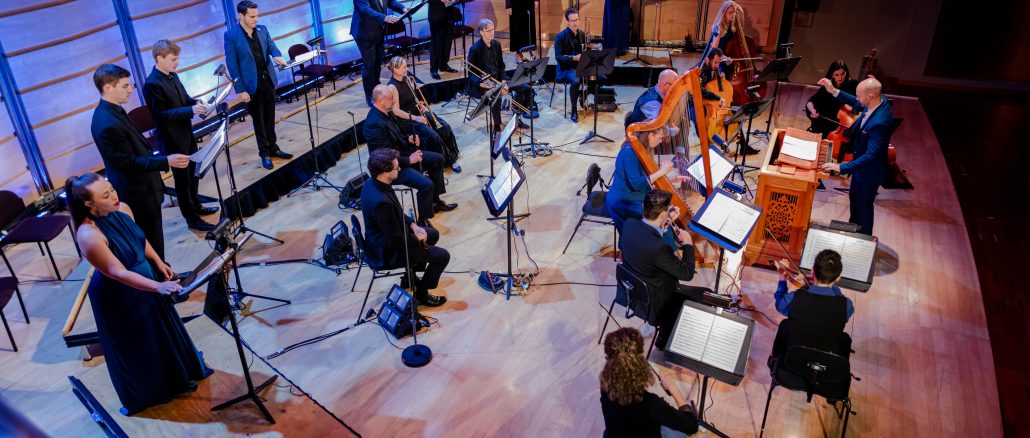
The beginning of Monteverdi’s Vespers is undoubtedly one of the finest opening choruses ever composed, and Pinchgut Opera’s rendition on Friday 29 July in the NECOM auditorium was stunning. This was the second 2022 concert organised by Musica Viva Armidale and the New England Conservatorium of Music. A tenor soloist sang the traditional versicle from Psalm 70 (“Make haste, O God, to deliver me”) then a great and glorious wall of sound engulfed us, grabbing us by its sheer brilliance and clarity. Eight solo singers (from Cantillation) sang repeated monumental chords of the same tonality against moving inner parts from thirteen instrumentalists (from the Orchestra of the Antipodes) playing on period instruments. It was clear that this performance with Erin Helyard conducting and playing the chamber organ, was going to be very special indeed!
Helyard chose to present it in the same way that Monteverdi probably would have himself, back around 1610, with one voice or instrument per part, rather than using a massed choir and orchestra. Having sung in a massed choir version many years ago, I knew the music well, but this historically informed performance was particularly beautiful and far more interesting. All the singers were experienced professional soloists with distinctive voices, so both their different timbres and differing personalities could be appreciated. Some had a more demonstrative style of presentation than others, and they all wore their own individual dress. One of the singers to whom I spoke later, explained that working with Erin was very inspiring, as he carefully chose his singers, based on a clear picture of the type of sound he wanted, and he respected the different approaches they brought to the table. Rehearsing became a collaborative and creative effort. It was obvious in this performance how much everyone was enjoying making this wonderful music together! The period instruments, which Erin introduced to the audience in a short chat before the performance, were also interesting with distinctive appearance and timbres. The harp, theorbo, chamber organ and lirone formed the continuo section and there were also three sackbuts, two curiously tapered cornetti, a descant recorder, two small baroque violins, a basse de violon, and two viola da gamba. All were pitched to A440.
Research suggests that Monteverdi (1567-1643) composed the Vespers with the intention of demonstrating his mastery of all the contemporary styles of composition. He dedicated it to the Pope, hoping to get a lucrative post in Rome, as he was unhappy working as court composer for the Duke of Mantua. The publication of his Vespers did enhance his reputation, and in 1613, he landed the position of maestro di cappella at the Basilica di San Marco in Venice where he stayed for the rest of his life.
We did not have surtitles for the Armidale performance, but Erin and Genevieve Lang had made a 15-minute preconcert podcast which was well worth hearing. Erin mentioned how cleverly Monteverdi would constantly pull the listener’s focus by alternating large tutti passages (full forces) with smaller forces, so for example, the tenth piece “Lauda Jerusalem” had two 3-part choirs and tenors singing the cantus firmus in a rich full sound, which was then followed by “Sancta Maria” sung so beautifully by a single soprano line accompanied by eight instruments. He would often use polychordal imitation for its aural effects, so your ears were drawn here and there, hearing echoes. All the singers were excellent and when they joined together in the big choruses, the sound was huge. There was never a note out of tune or an ending that wasn’t perfect. The staging was also carefully worked out to maximise the effects of imitation in the music. The soprano duet for example was sung with each singer standing far apart, one on either side of the stage, so we could appreciate the beautiful way they imitated each other in stereo. The lighting was lovely and the acoustics in the auditorium were helped by the new acoustic panels erected on the stage too.
Erin had aptly described the whole work as “having a sense of sacred space” and as “music that often hung in the air”. It was certainly magical and there was never a dull moment for all 70 minutes. The piece did not conform to any liturgical vespers we know. Monteverdi composed it more as a resource book of sacred music. Some of the most beautiful moments for me were “Nigra Sum: I am sunburned and beautiful”from the Song of Songs sung by solo tenor, where Monteverdi used monody – a melody with chordal accompaniment – which was a huge innovation in his day, and “Pulchra es” where the two sopranos sang in parallel thirds.
Despite the fact we were in mid-winter, there was no coughing from the audience. I think we were all spell-bound by this performance.
Inge Southcott